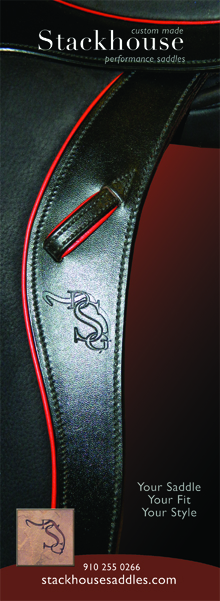Search the Site
Video # 16: This is Briana and Henry at the American Eventing Championships! (Current freebie!)
Briana, you guys look great! I can tell that you've been working on some of the things we have discussed. I'm curious as to what you did as you were going around the dressage ring, as he was so nicely on the aids as the test began.
He starts to lose that nice connection a little at :22. Make sure that you really use every corner in your test to try to improve your connection. Every corner is an opportunity to get him a bit more up into the outside rein. And if you can achieve that, you will come out of the corner more solidly on the aids.
Your downward transition to the walk at 1:22 was a little abrupt and on the forehand. Sit the trot a few strides before asking, and half halt to prepare for the transition. He has a great free walk, but you need to use the corner at the end of the free walk to more fully get him back on the aids before your trot transition. It can help to think of a few slight steps of turn on the forehand in that corner to get him more solidly up into the outside rein. That way he will stay more connected into the trot. That little "hop" that he did is because his hind legs weren't underneath his body enough.
Also try to prepare more for your canter transitions, by doing some half halts to get him more connected before you ask for the canter. In your second canter transition he was behind your leg as well as not connected. Don't be afraid to fix those problems in the ring. In the half circle in the trot approaching that second canter transition I would have been more actively riding him forward and up into that outside rein. It looks like maybe you got a bit tentative because you could feel him anticipating the canter transition? Don't back off if you feel the horse thinking about doing something wrong. Keep riding positively forward, feel the trot rhythm in your hips to help him keep the trot, and improve the connection from behind to prepare for your canter transition.
You overshot your final turn down the center line a little, and had to swerve back to the center line, which is always unbalancing. Use more outside aids while maintaining inside bend to really nail that turn, which will set you up for a good final halt.
On cross country, you need to shorten your reins and get up off of his back between jumps. While you are up off of his back between fences, if you bring your hips back and keep your knuckles down on the neck, it will help you to keep his stride more organized. He tends to get long and strung out in his gallop, which can make that awkward takeoff spot show up regularly. He will be more adjustable, and will handle off distances with better balance, if you keep his gallop a bit more together.
For your stadium round, I would have planned to give yourself more room for your opening circle. You had a good canter right before you ran out of room and had to turn tight. Too much inside rein on that turn then made him swap out behind at 7:08. The canter to your first jump was good, although your reins are still a little long. Your first jump is great, and then he lengthened his frame and his stride a little to jump # 2, which made him jump that a little over his front end. You rode well up to the third, and did nothing to cause the rail down there. He just tends to struggle a bit when he gets close to a jump and his balance is long. His stride and balance were just a little long at 4 A and 4 B, which caused him to get "underneath" 4 B at 7:48. Henry was making 12 and a half foot strides in front of and in the combination, when 12 foot strides were required to make the distance work perfectly.
More outside aids on the approach to fence # 5 would have kept him straighter. Centrifugal force has him falling a little to the right, which was why he swapped leads in front in the final strides of the approach. Fence # 6 looked good, and # 7 was my favorite jump on course. Watch how you keep him straight with your outside aids to let the turn help bring him into a more uphill balance at 8:18. He then gets long again to jump # 8. If you had a better connection with the reins and packaged his canter a bit more, he would have fared better at # 8. But he definitely finds his vertical jumps more challenging than his oxers balance wise.
Again the left turn to # 9 has him leaning his weight too much over his right shoulder. Try to keep his neck very straight (even a counter bend) through your left turns. Your last jump was very nice. He looks easier to keep straight on the right turned approaches.
A little shorter rein and more packaging of his canter stride, both in cross country and in stadium jumping, will help him be in a better balance to better handle the deeper distances. Keep doing lots of the adjustability exercise!






